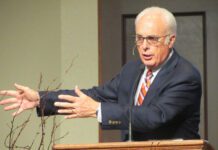Although there are several preaching styles, nearly all sermons these days fall into two broad categories: textual and topical. Given that numbing lack of variety in form, it is no wonder many congregations (and not a few preachers) have grown bored with the sermon as the centerpiece of Protestant worship.
Perhaps it is time to recover two elements that were once hallmarks of great preaching: imagination and creativity.
Textual sermons begin with the text. The preacher chooses a single passage does not move beyond its original meaning. This includes several sermon types, including expository sermons, Bible teaching, homily and many exhortative sermons. “Scripture cannot mean what it never meant” is the mantra of the textual preacher, who works hard to present exactly what the original writer is thought to have meant.
Topical sermons begin with a subject. They make freer use of the text while speaking about a particular topic, such as the doctrine of grace, the Christian view of marriage, social justice or sexual morality. Topical preachers take the gist of a text and develop a sermon around it, sometimes using several texts from various parts of the Bible to support the topic.
These sermons all rely on propositional argument. They often consist of “three points and a poem,” meaning that they present a central thesis supported by several (often three) propositions and a bit of illustrative material (that’s the “poem”—stories, video, quotations, etc.).
Both forms are good and certainly have their place. Yet there are many other sermon forms used by highly respected preachers of the past.
For example, Dr. Martin Luther King’s celebrated sermon “A Knock at Midnight” is a straight-up allegory based on Jesus’ parable of the importunate friend. King acknowledges that he is abandoning the standard, historical interpretation of the text, which concerns persistence in prayer, to find an alternative meaning. He then uses elements of the story as symbols for the moral state of America, its leadership and the church in the mid-20th century.
King was a highly effective preacher who practiced something like Midrash, the Jewish tradition of interpreting a text imaginatively. This interpretive method sees a biblical text as laden with meanings, some yet to be discovered, and not merely as a wagon used to carry a single theological proposition.
This imaginative style of interpretation is very much in keeping with the holiness tradition of preaching I recall hearing years ago. Yet as preachers and their audiences became more intellectual, creative preaching was all but abandoned. Preachers became historical-critical scholars, and congregations came to expect Bible lectures on Sunday morning.
To be sure, a preacher must have a grasp of biblical hermeneutics, theology and the history of Bible interpretation. We don’t look for novel interpretations, and we don’t impose our own ideas upon it (at least we try not to). But an experienced preacher may well go beyond giving history lessons on Sunday to preach in more creative and persuasive forms.
Here are 10 types of creative sermons that may push the preacher to greater imagination and creativity, and may help draw hearers deeper into the text.
1. Allegory
An allegorical sermon, like King’s “Knock at Midnight,” uses elements of a biblical text to signify other concepts. I recently heard a great allegorical message by Lenny Luchetti on the subject of the church, using the story of Jacob, Rachael and Leah. The historical meaning of the Jacob story has nothing to do with church shopping or religious consumerism, yet Luchetti powerfully developed his thesis using the idea that “radiant Rachael” represents the ideal church that everyone desires, “less-than-lovely Leah” represents the real-life congregations that we all get stuck with, and Jacob is the church member trying to reconcile vision with reality. Allegorical sermons work best with a familiar scripture, probably a narrative or perhaps a poetic text.












